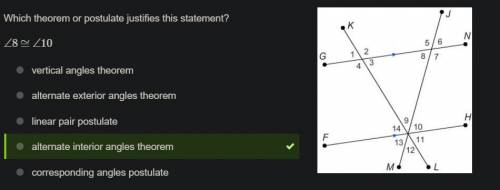Which theorem or postulate justifies this statement?
∠8≅∠10
alternate interior angles t...

Mathematics, 19.10.2020 08:01, brainzz04
Which theorem or postulate justifies this statement?
∠8≅∠10
alternate interior angles theorem
corresponding angles postulate
alternate exterior angles theorem
vertical angles theorem
linear pair postulate
The figure shows parallel line segments G N and F H rising slowly from left to right with segment G N above segment F H. Line segment K L falls steeply from left to right, first intersecting segment G N and then segment F H. Line segment M J rises steeply from left to right, first intersecting both segment F H and segment K L at their point of intersection and then intersecting segment G N. The 4 angles at the intersection of segments G N and K L are numbered from 1 through 4 in a clockwise direction with angle 1 above segment G N and to the left of segment K L. The 4 angles at the intersection of segments G N and J M are numbered from 5 through 8 in a clockwise direction with angle 5 above segment G N and to the left of segment J M. The 6 angles at the intersection of segments F H, K L, and J M are numbered from 9 through 14 in a clockwise direction with angle 9 above segment F H, to the right of segment K L, and to the left of segment J M.

Answers: 2
Other questions on the subject: Mathematics

Mathematics, 21.06.2019 14:00, etxchrissy
Which graph represents the solution of the inequality?
Answers: 1

Mathematics, 21.06.2019 15:00, BeautyxQueen
Find three consecutive numbers such that the sum of one-fourth the first and one-fifth the second is five less than one-seventh the third
Answers: 1

Do you know the correct answer?
Questions in other subjects:

History, 08.12.2019 21:31


Arts, 08.12.2019 21:31


English, 08.12.2019 21:31

Biology, 08.12.2019 21:31



History, 08.12.2019 21:31








